Nature Conservation 2024 — 30. 5. 2024 — Nature Conservation Legislation — Print article in pdf
Look Back at the Presidency of the Czech Republic in the Council of the European Union
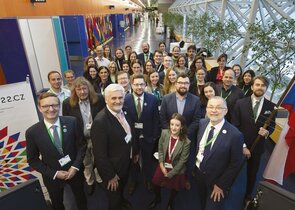
It doesn’t matter where you are coming from.
All that matters is where you are going.
Brian Tracy: The psychology of achievement (2002)
In international agenda related to nature conservation/biological diversity, the second half-year of 2022 was marked by a whole range of actions both on the global or pan-European level and in the European Union. Due to the COVID-19 pandemic, many meetings of Multilateral Environmental Agreements (MEAs), i.e. hard laws, and of some United Nations bodies which should adopt their future direction had to be repeatedly postponed and rescheduled. Therefore, they heavily accumulated in the second half of 2022. The Czech Republic implemented its already second presidency in the Council of the European Union (CZ PRES 2022) just between 1 July and 31 December 2022, thus facing an unprecedented challenge.
The Presidency has no leave
As early as 3 July 2022, the ninth session of the Plenary of the Intergovernmental Science-Policy Platform on Biodiversity and Ecosystem Services (IPBES) began in Bonn, Germany. During a one-week meeting, participants approved assessments prepared by the above United Nations scientific panel aiming at the sustainable use of wild species of animals, plants and other organisms, e.g. fungi or algae (IPBES 2022a) and at the diverse conceptualization of multiple values of nature and its benefits, including biodiversity and ecosystem processes, functions and services (IPBES 2022b).
Informal meeting of the EU Member States’ environment ministers took place in Prague 12 – 14 July 2022 dealt particularly with biological diversity protection, conservation and management, wide-ranging impacts of war in Ukraine on the environment and last, but not least with climate change adaptation both in human society and the environment. The heads of the sector agreed that the EU intents to protect and conserve nature even more and mainly better than up to now. The Nature Conservation Agency of the Czech Republic in cooperation with the Department of Environmental Protection, Capital City of Prague Municipal Office organised for the participants of the meeting a field trip to the site of Lítožnice in eastern part of the Czech Republic’s capital presenting a model example of nature restoration.
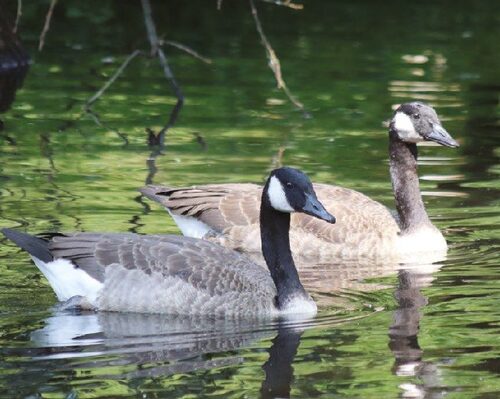
The Kunming-Montreal Global Biodiversity Framework sets for the Parties to the Convention on Biological Diversity ambitious targets to be met by 2030 also in reducing negative impact of invasive alien species on biodiversity. The Canada goose (Branta canadensis) originated from North America causes serious damages particularly in West and North Europe by eating crops and grazing in fields. © Jan Plesník
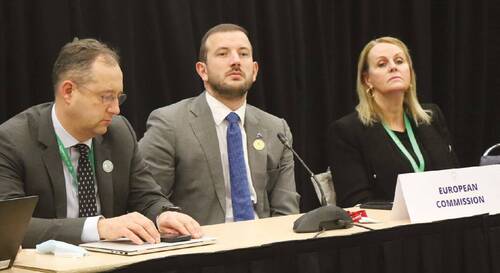
Virginius Sinkevičius, European Commissioner for the Environment, Oceans and Fisheries (in the middle) attended a high-level the segment of the 15th Meeting of the Conference of the Parties to the Convention on Biological Diversity in Montreal, Canada. © Jan Plesník
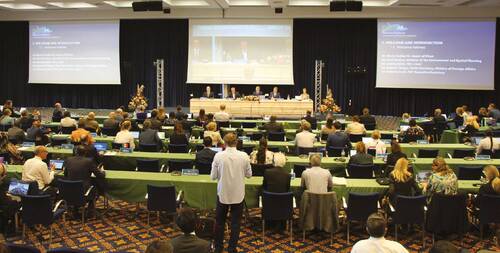
Look at a conference room in Portorož, Slovenia where the 68th Meeting of the International Whaling Commission was held. © Jan Plesník
Traditional events of every presidency of the Council of the EU also include Nature Directors’ Meeting. If we count in addition to directors responsible for nature conservation in each EU Member State representatives of interest groups/professional associations, NGOs and the European Commission, invitation for 29 – 30 September 2022 was accepted by approx. 80 officials. The meeting debating particularly the proposed Nature Restoration Law (EC 2022, Stejskal 2022) offered to participants possibility to meet field management implemented on the Raná Hill Site of European Importance (pursuant to Act No. 114/1992 Gazette on Nature Conservation and Landscape Protection, as amended later, the term for Site of Community Importance, SCI under the European Union’s Habitats Directive) in the České Středohoří/Central Bohemian Uplands Protected Landscape Area (northern Bohemia) where grazing by goats and sheep plays a crucial role. According to Nature Directors, the proposed Nature Restoration Law should allow Member States to use local and national conditions, traditions and capacities and to engage all stakeholders in its implementation.
From migratory birds to wetland protection and conservation
One of the reasons for step-by-step development in international nature conservation is the necessity to cooperate in efforts to preserve migratory species of wild animals regularly crossing borders of two or more countries. Therefore, within the Convention on the Conservation of Migratory Species of Wild Animals in total seven agreements aiming at conservation of the particular group of migratory species in a certain part of the world were negotiated. Since 1979, they have also included the Agreement on the Conservation of African-Eurasian Migratory Waterbirds (AEWA).
From 27 to 30 September 2022 the 8th Session of the Meeting of the Parties to the AEWA took place in Budapest. It improves the conservation status of 255 waterbird species migrating across an extensive area covering one third of the Earth’s surface. The newly adopted resolutions are well appropriate: of 495 waterbird populations protected by the AEWA which long-term data gathered by monitoring schemes are available for, 43 % have been declining and 33 waterbirds species have been facing extinction on a global scale (WI 2021). In the Hungarian capital, the European Union received an award for its generous, long-term and effective support and commitment to various initiatives supporting conservation of migratory species selecting wetland and water habitats.
In the course of the 68th Meeting of the International Whaling Commission convened to the Slovenian coastal resort of Portoroz for 13 – 21 October 2022, the Presidency of the Czech Republic of the Council of the EU on behalf of the EU, successfully managed adoption of decision trying to reduce marine plastic pollution impacts on cetaceans and marine habitats, from microplastics created by breaking down plastics, i.e. larger plastic debris through solar radiation and ocean water to fishing nets or lines that have been abandoned, lost or intentionally discarded in the ocean being sometimes dozens of kilometres long, called ghost nets (IWC 2023). If we do not do anything about the plastic pollution plastics will outweigh fish in the world’s oceans by 2050 (EMF 2016). Filter-feeding cetaceans are particularly threatened by microplastics (IWC 2020, Kahane-Dapport et al. 2022).
According to respected estimations there has been loss of 64–71% of wetlands globally since 1900 AD (Davidson 2014). Due to land conversion, the extent of natural wetlands declined by 35% since 1970 when the necessary data have been available: they have been disappearing 3.7 times quicker than forests (Convention on Wetlands 2021). Therefore, as early as in February 1971, the global Convention on Wetlands of International Importance Especially as Waterfowl Habitat, according to the site of signing in Iran called the Ramsar Convention, was signed.
The 14th Meeting of the Parties to the above international hard law was officially hosted by China in the due to spreading the SARS-Cov-2 virus notorious city of Wuhan 5 – 13 October 2022 but finally it was held in Geneva, Switzerland. In addition to consensus on better wetland protection, management and restoration the delegates also supported measures aiming at communication with, education of and raising awareness among the general public and the target groups, e.g. the youth. The meeting also adopted resolution focusing on damage to wetlands in Ukraine, including at least 16 Ramsar Sites (Wetlands of International Importance) stemming from the Russian Federation’s aggression: by September 2022, 6,000 km2 of wetlands protected by the Ramsar Convention have been destroyed there. The EU Presidency team from the Czech Republic significantly contributed to the adoption of the resolution.
The Presidency of the Czech Republic in the Council of the European Union and CITES
The Presidency of the Czech Republic in the Council of the European Union team for biodiversity-related issues was also involved in key negotiations within the Convention on International Trade in Endangered Species of Wild Fauna and Flora (CITES).
Meetings of the Conference of the Parties to the CITES discuss not only the Convention’s operations but also debate wildlife taxa threatened just by international trade (Jelínková 2017, Plesník et al. 2019). The same applied for the 19th meeting organised in Panamá City, Panama 14 – 25 November 2022. Delegates, inter alia, rejected to allow trade in ivory from Southern Africa populations of the African bush elephant (Loxodonta africana) as well as in horns from the Southern white rhino (Ceratotherium s. simum) because otherwise poaching these large mammals could be stimulated.

The 19th meeting of the Conference of the Parties to CITES was held at the Panama Convention Centre launched in Panamá City in 2020. It is located close to the Pacific Entrance of the Panama Canal and has capacity up to 23,000 guests. © Jan Plesník
At the same time both export and import of timber from 150 tree species including to Europe imported highly priced hardwood of African tropical trees from the genus Afrelia used, inter alia, for furniture production, become tightened up. Stricter rules shall also be applied for international trade in lot of amphibians and reptiles, e.g. the Laos warty newt (Laotriton laoensis) or the Chinese water dragon (Physignathus cocincinus). Thus, CITES has also been protecting the family Centrolenidae. Their members conceal blood in their liver to maintain transparency when sleeping (Taboada et al. 2022): therefore, they are to the point called the glassfrogs. Yet non-protected hammerhead shark species from the family of Sphyrnidae have newly been taken under the CITES’ wings and chondrichthyans from the family of requiem sharks (Carcharhinidae) shall have stricter protection, too. Bottom line: more than 500 wildlife species and subspecies can fully and directly benefit from stricter regulating international trade.
The fact that the Presidency of the Czech Republic in the Council of the European Union took a reasonable approach to transboundary regulation of flora and fauna trade can be evidenced by the case of the Pernambuco wood or Brazilwood (Paubrasilia echinata). Its timber is commonly used for producing bows. Brazilian proposal to regulating trade in the tree species more strictly would result in the fact that every musician owning a bow from the timber would have to receive a respective CITES permit when travelling abroad. The compromise agreed allows Brazil – the species occurs only there – to regulate the trade both with wood itself and products made of it exported from the South American country while the subsequent re-export does not require the CITES permission.
International nature conservation is also pan-European
MEAs having been mentioned yet have a global scope. In wider Europe, natural heritage has been protected and conserved by the Convention on the Conservation of European Wildlife and Natural Habitats or the Bern Convention since 1979.
Because the Parties to the Bern Convention, contrary to other MEAs, do not pay any fees and financial support from the Council of Europe has been declining, the 42nd Meeting of the Standing Committee held in Strasbourg, France 28 November to 2 December 2022 dealt with its further financing. Measures trying to minimize illegal bird killing, spreading of pathogens by invasive alien species or protecting sturgeons (Acipenseridae) and large carnivores as well as building-up the Emerald Network of Areas of Special Conservation Interest were also debated during the event. A considerable part of the meeting was traditionally dedicated to public discussion of the case files, i.e. issues when a Party has been breaching the duties raised from its ratifying the Bern Convention.
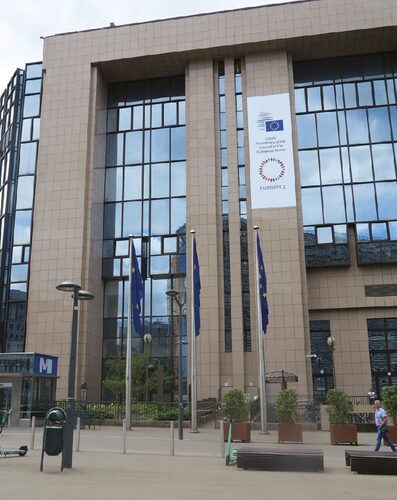
A front wall of the Justus Lipsius Building in Brussels used by Council of the European Union in Brussels was decorated by the logo of the Presidency of the Czech Republic in the Council of the European Union from 1 July to 31 December 2022. © Jan Plesník
Finis coronat opus or the crown ends the work
Without downplaying the importance of the above meetings let us remember that the Presidency of the Czech Republic in the Council of the European Union in international biodiversity agenda culminated at the second part of the 15th Meting of the Conference of Parties to the Convention on Biological Diversity (CBD COP15). The meeting, originally scheduled for October 2020, had had due to restrictions against the COVID-19 syndemic to be four times postponed. Meantime, 11 – 15 October 2021 China as a CBD COP15 host country organized the first rather symbolic and mostly virtual part in Kunming aiming particularly at CBD’s operational issues and including also the high-level segment.
Because measures against COVID-19 in hosting country had made impossible holding the meeting in a reasonable time framework there it was necessary to seek for where the event could be organized even by the end of 2022. It was the Canadian government that got the CBD out of tight spot by offering to host the meeting in Montreal, a seat of the CBD Secretariat for more than a quarter of a century, within the United Nations Conference on Biodiversity from 7 to 19 December 2022. An interview with the first author of the article deals with the course and outputs of the Montreal negotiations and we shall present them in one of next issues: therefore, now in a really telegraphic way.
Adopting the Kunming-Montreal Global Biodiversity Framework (GBF, UNEP 2022a) was the most important and at the same time the most expected output not only of the CBD COP15 but also four-year consultation and negotiation process. Finally, the document, adopting of which was literally hanging in the balance in Montreal, consists of four goals that should become a reality by 2050 so that world is living in harmony with nature. Halting and reversing biological diversity loss should be enhanced by 23 again highly ambitious action-oriented targets that the Parties obliged themselves to meet already by 2030.
Contrary to the previous 2010 Biodiversity Target or a set of the Aichi targets adopted by the CBD in 2010 which were not met by the international community, most of the GBF targets are quantitative, the Partis shall constantly report on their efforts to achieve them and the GBF also includes financial commitments for global biodiversity conservation, management and sustainable use (Gilbert 2002, UNEP 2022b). Although we would like not to blow our own trumpet, the outputs reached in Montreal are a marked success of the Presidency of the Czech Republic in the Council of the European Union.
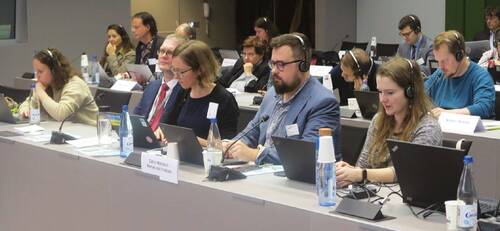
In December 2022, the Czech Republic’s delegation coordinated the EU Member States during the 42nd Meeting of the Bern Convention Standing Committee held at the Council of Europe premises in Strasbourg. © Jan Plesník
A symbolic taking off a hat
In the previous article (Miko & Plesník 2022) we voiced our presumptuous hope that CZ PRESS 2022 in nature conservation will be finally honourable. It is appropriate here to sincerely acknowledge and to express real admiration for all who anyhow contributed – today we can immodestly say it – to success of the Presidency of the Czech Republic in the Council of the European Union in the biodiversity agenda. Numerous genuine responses and reactions confirm that it was really much better than “only” honourable. ■
- - - -
The list of references is attached to the online version of the article at www.casopis.ochranaprirody.cz
- - - -
Cover photo:
The Czech Republic’s team of 40 people acting in Montreal on behalf of the European Union did great job: according to some opinions of delegates from other countries even with flying colours. © European Commission archive

